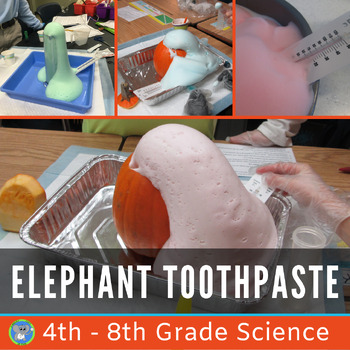Tips To Take The Elephant Toothpaste Demonstration Up a Notch with a Lab Report
Elephant toothpaste is a fantastic chemical reaction. It speeds up the process of hydrogen peroxide becoming water and oxygen. A foamy reaction and heat are produced. So much fun!
Watch the video explanation on YouTube.
Typically this is done as a demonstration. If we want students to truly understand the reaction we need to take it up a notch and make it an experiment. This will help students understand the why and the how.
Any good experiment should have a lab report. Elephant toothpaste is the perfect lab for learning to complete a lab report. Since it is so exciting students will be more eager to write down what is happening. Check out this lab report to help guide students in discovering this magnificent reaction.
Here are some great tips for turning your
elephant toothpaste activity into a lab report.
1. Make sure it follows the scientific method. This will give purpose to the activity and allow students to focus on science concepts. It will help develop the student's scientific inquiry skills. It should allow students to write a hypothesis, record data and observations, create a graph, and summarize their results.
2. Making a change and conducting it several times will help reinforce what is happening. For elephant toothpaste, there are so many things we can change.
Possible Changes
amount of water
the temperature of the water
brand or strength of hydrogen peroxide
type of yeast
amount of yeast
brand of yeast
3. Writing down the steps will allow students to understand the experiment better. When you watch a demonstration you are just focusing on the results. Having a lab journal allows students to see the whole process. They will be taking the lead in their learning.
In elephant toothpaste we want students to understand that yeast is a catalyst. It speeds up the reaction of hydrogen peroxide becoming oxygen gas and water. Completing the steps and recording them will help students to understand why the materials are being used.
4. Make sure there is a clear effect to measure. In science, this is the dependent variable. It is what I am recording data on to see how the change affects the reaction.







